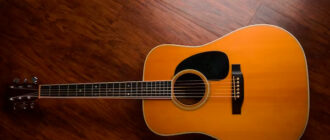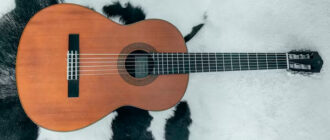
How to do Drop D Tuning: Hey there, fellow guitar enthusiasts! Today, we’re diving into the world of drop D tuning. Whether you’re a beginner or a seasoned guitarist, drop D tuning can open up a whole new realm of possibilities for your playing. In this guide, we’ll cover everything you need to know about drop D tuning, from how to tune the lowest string of your guitar to the benefits and drawbacks of this popular alternative tuning. So, prepare to play guitar even more professionally, and let’s get started!
Table of Contents
What Is Drop D Tuning?
To get into drop d tuning, you need to first know what it is. Drop D tuning is a popular alternative tuning where the lowest string of your guitar, the E string, is tuned down to a D. In standard tuning, the intervals between the strings are E-A-D-G-B-E, but in drop D tuning, it becomes D-A-D-G-B-E.
This simple adjustment can have a profound impact on your playing, especially in genres like rock and metal where playing in drop d tuning is pretty common for guitar players. You might have heard about it in guitar lessons if you are taking any for an electric or acoustic guitar. It is used for a power chord in songs, where even one string in open d tuning make a big difference, because it shifts an octave.
Why Learn Drop D Guitar Tuning?
There are several reasons why learning drop D tuning can greatly enhance your playing. Firstly, it makes it easier to play power chords, high notes and open chords in the key of D, creating a heavy and punchy sound that’s perfect for rock songs. Additionally, drop D tuning allows you to play with lower pitch and explore new chord shapes and voicings, giving your music a unique flavor.
For advanced players, there is also drop C tuning, and for some songs you can drop two notes meaning two strings, fifth string and fourth string or even three strings with the lowest E or with DADGAD tuning. But this depends on the skill to change the fretboard arrangement and the ability to play chords an octave lower because it makes playing harder. But it is suitable for lower voices and lower notes. Perfect pitch is not obligatory, but it is much easier to change string tunings, including E minor, when you hear the minor differences. Drop d tuning also makes the sound deeper.
How to do Drop D Tuning

Image by Edgar from Unplash
Tuning your guitar to drop D is actually quite simple. You need to tune your low E string down to a D. The method to achieve drop D tuning alters.
1. Using a tuner: This is the most accurate and beginner-friendly method. Just follow the instructions on your tuner and adjust the tuning peg until the tuner detects the correct pitch. This way of tuning also makes it easier to return and play a chord in standard tuning, it is one of the easiest ways to change the tuning of your six strings down a full step.
2. By ear: If you have a good sense of pitch or want to develop your ear-training skills, you can tune your guitar by comparing the sound of the low E string to a reference note, such as the D string on the 5th fret of the A string. This tuning means you might make a mistake on your sixth string, but there is no learning without mistakes. Drop d is a common way to start training your ear while turning the tuning on your acoustic or electric guitar.
How Do You Tune a D String?
Once your low E string is tuned to a D, you’ll need to ensure that the rest of the strings are in tune as well. You can use a tuner or your ear to tune the other strings, following the standard tuning intervals (D-A-D-G-B-E). Drop d makes other strings sound unusual to an untrained ear because the guitar is tuned to an unusual configuration. Be careful while with the tuned guitar because tuning may cause damage if you are doing it too harshly. The tuner for tuning is made for a reason, use it if you are not sure in your skills.
How Do You Tune to D Flat Tuning?

Image by Ariyo Aanu from Unplash
If you’re interested in exploring even lower tunings for the metal genre, such as D flat (Db) tuning, the process is similar. Start by tuning your low E string down to a Db, and then tune the rest of the strings accordingly (Db-Ab-Db-Gb-Bb-Eb), paying more attention to the 4th string because it might be difficult to play an open chord if it is not tuned right. This tuning is commonly used in genres like metal and can add an extra level of heaviness to your playing.
How Do You Get into D Standard Tuning?
D standard tuning, also known as whole-step down tuning, is another popular alternative tuning that is achieved by tuning all the strings down a whole step (D-G-C-F-A-D). This tuning is favored by bands like Foo Fighters and Led Zeppelin, and it can give your guitar a deeper, fuller sound. You need to make sure to remember which tuning your guitar has if you don’t have perfect pitch and cannot guess from the sound.
Drawbacks of Drop D Tuning:
While drop D tuning offers numerous benefits, it’s important to be aware of its drawbacks. One of the main challenges is that some chord shapes and melodies that are easy to play in standard tuning can become more difficult in drop D. It may take some time to adjust and develop new techniques to overcome these challenges.
Tips:
1. Experiment with different chord shapes and voicings to take advantage of the unique characteristics of drop D tuning.
2. Explore songs that use drop D tuning, like “Everlong” by Foo Fighters or “Moby Dick” by Led Zeppelin, to get inspired and learn new techniques.
3. Consider using a dedicated drop D tuner for quick and easy tuning adjustments on the fly.
Warnings:
1. Remember to be mindful of the tension on your guitar neck when tuning to lower pitches. If you frequently switch between different tunings, it’s advisable to have your instrument properly set up and adjusted by a professional.
2. Drop D tuning isn’t suitable for every genre or style of music. Make sure to choose the tuning that best fits the sound you’re aiming for.
Congratulations! You’ve now unlocked the power of drop D tuning. By exploring this alternative tuning, you’ve expanded your musical horizons and gained a great skill that can enhance your playing in genres like rock and metal. Remember to practice and experiment with your new tuning to fully grasp its potential. So, go ahead, strum those power chords, unleash your creativity, and rock on!






